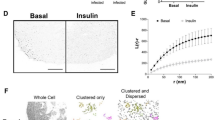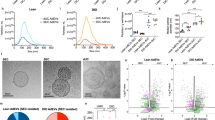Abstract
Objective:
The direct effects of adipokines on skeletal muscle metabolism have been well established. As the combinatorial effects of adipokine mixtures are likely to be of more physiological relevance, we used a coculture system of primary rat adipocytes and L6 skeletal muscle cells to examine the effects of adiponectin derived from primary rat adipocytes on rat skeletal muscle cells.
Results:
We showed that coculture with adipocytes stimulated glucose uptake in L6 cells within 30 min and this correlated with an increase of glucose transporter isoform 4 (GLUT4) localization to the plasma membrane. These effects were dependent on the reorganization of the actin cytoskeleton, demonstrated by rhodamine-labeled phalloidin immunofluorescence, as cytochalasin D attenuated the glucose uptake induced by adipocyte-conditioned media. Temporal analysis revealed that enhanced glucose uptake was maintained after 24 h of coculture, and this was attributed to an increase in both GLUT1 expression and the cell surface content of GLUT4. We established a role for adiponectin in mediating these effects as antibody-mediated neutralization attenuated the metabolic effects of adipocyte-conditioned media. Furthermore, compound C blocked these effects, suggesting an important role for AMPK. Importantly, when we compared the effects of full-length recombinant adiponectin with adipocyte-conditioned media, we confirmed that recombinant adiponectin was unable to stimulate glucose uptake in L6 cells despite having an important role in adipocyte-conditioned media.
Conclusions:
Our results demonstrate the importance of examining the effects of adipokines in the context of physiologically relevant mixtures to accurately determine their metabolic effects on skeletal muscle.
This is a preview of subscription content, access via your institution
Access options
Subscribe to this journal
Receive 12 print issues and online access
$259.00 per year
only $21.58 per issue
Buy this article
- Purchase on Springer Link
- Instant access to full article PDF
Prices may be subject to local taxes which are calculated during checkout






Similar content being viewed by others
References
Halaas JL, Gajiwala KS, Maffei M, Cohen SL, Chait BT, Rabinowitz D et al. Weight-reducing effects of the plasma protein encoded by the obese gene. Science 1995; 269: 543–546.
Scherer PE, Williams S, Fogliano M, Baldini G, Lodish HF . A novel serum protein similar to C1q, produced exclusively in adipocytes. J Biol Chem 1995; 270: 26746–26749.
Hu E, Liang P, Spiegelman BM . AdipoQ is a novel adipose-specific gene dysregulated in obesity. J Biol Chem 1996; 271: 10697–10703.
Maeda K, Okubo K, Shimomura I, Funahashi T, Matsuzawa Y, Matsubara K . cDNA cloning and expression of a novel adipose specific collagen-like factor, apM1 (AdiPose Most abundant Gene transcript 1). Biochem Biophys Res Commun 1996; 221: 286–289.
Kershaw EE, Flier JS . Adipose tissue as an endocrine organ. J Clin Endocrinol Metab 2004; 89: 2548–2556.
Ceddia RB, Koistinen HA, Zierath JR, Sweeney G . Analysis of paradoxical observations on the association between leptin and insulin resistance. FASEB J 2002; 16: 1163–1176.
Fang X, Sweeney G . Mechanisms regulating energy metabolism by adiponectin in obesity and diabetes. Biochem Soc Trans 2006; 34: 798–801.
Kadowaki T, Yamauchi T . Adiponectin and adiponectin receptors. Endocr Rev 2005; 26: 439–451.
Yamauchi T, Kamon J, Waki H, Terauchi Y, Kubota N, Hara K et al. The fat-derived hormone adiponectin reverses insulin resistance associated with both lipoatrophy and obesity. Nat Med 2001; 7: 941–946.
Berg AH, Combs TP, Du X, Brownlee M, Scherer PE . The adipocyte-secreted protein Acrp30 enhances hepatic insulin action. Nat Med 2001; 7: 947–953.
Yamauchi T, Kamon J, Waki H, Imai Y, Shimozawa N, Hioki K et al. Globular adiponectin protected ob/ob mice from diabetes and apoE deficient mice from atherosclerosis. J Biol Chem 2002; 12: 12.
Wang C, Mao X, Wang L, Liu M, Wetzel MD, Guan KL et al. Adiponectin sensitizes insulin signaling by reducing p70 S6 kinase-mediated serine phosphorylation of IRS-1. J Biol Chem 2007; 282: 7991–7996.
Mao X, Kikani CK, Riojas RA, Langlais P, Wang L, Ramos FJ et al. APPL1 binds to adiponectin receptors and mediates adiponectin signalling and function. Nat Cell Biol 2006; 8: 516–523.
Moller DE . Potential role of TNF-alpha in the pathogenesis of insulin resistance and type 2 diabetes. Trends Endocrinol Metab 2000; 11: 212–217.
Lee DE, Kehlenbrink S, Lee H, Hawkins M, Yudkin JS . Getting the message across: mechanisms of physiological cross talk by adipose tissue. Am J Physiol Endocrinol Metab 2009; 296: E1210–E1229.
Patel N, Huang C, Klip A . Cellular location of insulin-triggered signals and implications for glucose uptake. Pflugers Arch 2006; 451: 499–510.
Khayat ZA, Tong P, Yaworsky K, Bloch RJ, Klip A . Insulin-induced actin filament remodeling colocalizes actin with phosphatidylinositol 3-kinase and GLUT4 in L6 myotubes. J Cell Sci 2000; 113 (Pt. 2): 279–290.
Tsakiridis T, Vranic M, Klip A . Disassembly of the actin network inhibits insulin-dependent stimulation of glucose transport and prevents recruitment of glucose transporters to the plasma membrane. J Biol Chem 1994; 269: 29934–29942.
Vu V, Kim W, Fang X, Liu YT, Xu A, Sweeney G . Coculture with primary visceral rat adipocytes from control but not streptozotocin-induced diabetic animals increases glucose uptake in rat skeletal muscle cells: role of adiponectin. Endocrinology 2007; 148: 4411–4419.
Wang Y, Xu A, Knight C, Xu LY, Cooper GJ . Hydroxylation and glycosylation of the four conserved lysine residues in the collagenous domain of adiponectin. Potential role in the modulation of its insulin-sensitizing activity. J Biol Chem 2002; 277: 19521–19529.
Palanivel R, Vu V, Park M, Fang X, Sweeney G . Differential impact of adipokines derived from primary adipocytes of wild-type versus streptozotocin-induced diabetic rats on glucose and fatty acid metabolism in cardiomyocytes. J Endocrinol 2008; 199: 389–397.
Olefsky JM, Reaven GM . Effects of age and obesity on insulin binding to isolated adipocytes. Endocrinology 1975; 96: 1486–1498.
Ceddia RB, Somwar R, Maida A, Fang X, Bikopoulos G, Sweeney G . Globular adiponectin increases GLUT4 translocation and glucose uptake but reduces glycogen synthesis in rat skeletal muscle cells. Diabetologia 2005; 48: 132–139.
Yamauchi T, Kamon J, Minokoshi Y, Ito Y, Waki H, Uchida S et al. Adiponectin stimulates glucose utilization and fatty-acid oxidation by activating AMP-activated protein kinase. Nat Med 2002; 8: 1288–1295.
Wu X, Motoshima H, Mahadev K, Stalker TJ, Scalia R, Goldstein BJ . Involvement of AMP-activated protein kinase in glucose uptake stimulated by the globular domain of adiponectin in primary rat adipocytes. Diabetes 2003; 52: 1355–1363.
Palanivel R, Fang X, Park M, Eguchi M, Pallan S, De Girolamo S et al. Globular and full-length forms of adiponectin mediate specific changes in glucose and fatty acid uptake and metabolism in cardiomyocytes. Cardiovasc Res 2007; 75: 148–157.
Fang X, Palanivel R, Zhou X, Liu Y, Xu A, Wang Y et al. Hyperglycemia- and hyperinsulinemia-induced alteration of adiponectin receptor expression and adiponectin effects in L6 myoblasts. J Mol Endocrinol 2005; 35: 465–476.
Shibata R, Sato K, Pimentel DR, Takemura Y, Kihara S, Ohashi K et al. Adiponectin protects against myocardial ischemia-reperfusion injury through AMPK- and COX-2-dependent mechanisms. Nat Med 2005; 11: 1096–1103.
Liu Y, Chewchuk S, Lavigne C, Brule S, Pilon G, Houde V et al. Functional significance of skeletal muscle adiponectin production, changes in animal models of obesity and diabetes, and regulation by rosiglitazone treatment. Am J Physiol Endocrinol Metab 2009; 297: E657–E664.
Musi N, Goodyear LJ . AMP-activated protein kinase and muscle glucose uptake. Acta Physiol Scand 2003; 178: 337–345.
Mueckler M . Facilitative glucose transporters. Eur J Biochem 1994; 219: 713–725.
Pajvani UB, Hawkins M, Combs TP, Rajala MW, Doebber T, Berger JP et al. Complex distribution, not absolute amount of adiponectin, correlates with thiazolidinedione-mediated improvement in insulin sensitivity. J Biol Chem 2004; 279: 12152–12162.
Yang WS, Lee WJ, Funahashi T, Tanaka S, Matsuzawa Y, Chao CL et al. Weight reduction increases plasma levels of an adipose-derived anti-inflammatory protein, adiponectin. J Clin Endocrinol Metab 2001; 86: 3815–3819.
Acknowledgements
Funding was provided by the Canadian Institutes of Health Research via an operating Grant and the New Investigator award to GS, VV supported by a Doctoral Student Research Award from the Canadian Diabetes Association. XZ received support as a China Scholarship Council Visiting Scholar.
Author information
Authors and Affiliations
Corresponding author
Ethics declarations
Competing interests
The authors declare no conflict of interest.
Rights and permissions
About this article
Cite this article
Vu, V., Dadson, K., Odisho, T. et al. Temporal analysis of mechanisms leading to stimulation of glucose uptake in skeletal muscle cells by an adipokine mixture derived from primary rat adipocytes. Int J Obes 35, 355–363 (2011). https://doi.org/10.1038/ijo.2010.160
Received:
Revised:
Accepted:
Published:
Issue Date:
DOI: https://doi.org/10.1038/ijo.2010.160



